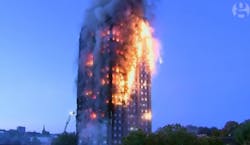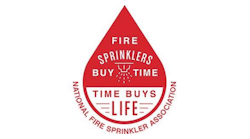July 17--Terrifying images from London remain fresh in many minds: Flames rapidly consuming the exterior of the 24-story Grenfell Tower while trapped residents frantically cried out for help from the upper floors, and firefighters physically and emotionally exhausted from the intense battle and loss of life they confronted.
The total confirmed deaths in the June 14 blaze remains at 34, but Metro Police officials have said they believe the final toll may wind up being closer to 80. Officials also say the number may take months to determine.
The questions that were asked here in the U.S. in the aftermath were the type you might expect: How could a fire burn out of control so quickly, and could a major incident like that happen here?
"The first thing that runs through your mind is that in this day and age, knowing all that we know and what we've learned in recent decades, how can we have fires like this occur? Not only of that magnitude, but the loss of life involved," Jim Pauley, president of the National Fire Protection Association, said in a recent interview with Firehouse.com.
While most fire officials would hesitate to say never, the safety of U.S. citizens who live or work in high-rise structures is on a stronger footing due to codes and regulations in place throughout the country. Sprinkler systems are required with any new high-rise construction in the U.S., but many jurisdictions are still tasked with making sure ownership of older buildings is working to retrofit their properties within a given time frame.
"If you think of new buildings in the last few decades or so, there's pretty good protection that's in place," Pauley said.
However, evidence that more work remains came this past Friday night when three people died in a fire at a non-sprinklered high-rise in Honolulu. A sprinkler system was also not in place at Grenfell, where a faulty refrigerator was blamed for sparking the inferno. Even though the exterior foam cladding of the London tower proved highly flammable, sprinklers would have greatly mitigated the interior damage and may have saved a great deal of lives.
"It didn't have to happen," Shane Ray, president of the National Fire Sprinkler Association, told Firehouse.com of his reaction to the Grenfell tragedy. "The sad thing is that as many as 400 people may die in high-rise fires here in America this year. Typically, if you don't have sprinklers, you have a fatality."
The silver lining to be found in tragic incidents such as Grenfell is that major changes and safety measures are usually not far behind. London council announced six days after the Grenfell fire that sprinkler systems would be installed in at least 25 other tower blocks to increase resident safety.
"One of the problems that we do have around fire today is the complacency that people really have," Pauley said, "and these large incidents heighten their awareness for a time period, so part of what we try to do is to figure out how we can put things into their hands that can take advantage of that heightened awareness and educate them more about fire safety."
In the wake of the Grenfell fire, the NFPA is working on a risk assessment tool for buildings with similar exterior cladding to assist local authorities globally with fire safety in their communities.
"The deadly fires that have occurred around the globe reflect a need to recommit and promote a full system of fire prevention, protection and education in order to help save lives and reduce loss," Pauley said.
Ray says that this year the NFSA appointed former Philadelphia Fire Commissioner Derrick Sawyer as its retrofit specialist, and the organization has a staff of engineers, lawyers and trainers to assist local fire chiefs and governments to meet their fire protection needs, including issues surrounding high-rise safety.
"Our approach is to assist the local fire chief," Ray said. "Our role is to help our members accomplish what they feel is best to protect their communities."
There have been numerous tragic yet educational incidents in high-rises here in the U.S., including the One Meridian Plaza fire in Philadelphia in February 1991 that claimed the lives of three firefighters and injured 24 others but led to major changes in the city concerning sprinklers. There was also a tragic fire at a senior living facility in a suburb of San Antonio in December 2014 that killed five people and led to a retrofit ordinance being put in place in the city.
"We have a lot of high-rise buildings in Philadelphia of all vintages and construction types so (high-rise safety is) something we think about a lot," Philadelphia Fire Commissioner Adam Thiel told Firehouse.com, adding that there are currently 28 high-rise construction projects in the city.
Thiel says a historic city such as Philadelphia presents unique challenges when it comes to retrofits because of the larger amount of older buildings, including colonial-era structures.
"We are doing whatever we can to provide outreach," he said.
Much younger cities like San Diego don't face as many retrofits, but high-rise construction has been on the rise there in recent decades. Of San Diego's roughly 230 high-rises, there are still 11 residential condominium complexes and two apartment high-rises that are not yet sprinklered, according to the city's Fire Marshal, Doug Perry.
"One mistake in a high-rise can affect the hundred families that live in there. So we're working right now to try and get the 13 remaining high-rises retrofit," Perry told Firehouse.com.
"The one thing we know in the fire service, and I think it's demonstrated day in and day out, is that if your buildings are sprinklered, your life safety is ten times, 100 times better."
Perry hopes the city can eventually reach the 100 percent mark when it comes to high-rises with sprinkler systems, but fire officials stress that owners, residents and firefighters remain vigilant when it comes to fire safety even if the building has a system installed.
"The moral of the story is we can take nothing for granted," Thiel said.
---
A list of the world's deadliest high-rise fires as compiled in a 2016 report by the NFPA (the number of deaths includes any firefighters who perished):
- September 2001 World Trade Center attack in New York - 2,666.
- February 1974 office tower fire in Brazil - 179.
- April 1995 bombing and fire in Oklahoma City - 168.
- December 1971 hotel fire in South Korea - 163.
- March 1911 clothing warehouse fire in New York - 146.
- December 1946 hotel fire in Georgia - 119.
- May 1972 multiple occupancy high-rise fire in Japan - 118
- November 2012 garment factory fire in Bangladesh - 112
- November 1973 department store fire in Japan - 104
- December 1986 hotel fire in Puerto Rico - 97.







